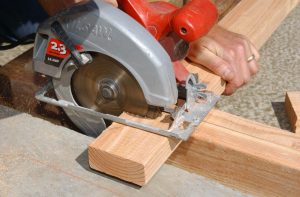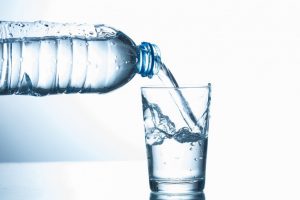 Potential Circular Saw Safety Mistakes
Potential Circular Saw Safety MistakesIt is statistically shown that more severe, debilitating injuries occur from the table saw than any other woodworking machine or power tool. When it comes to handheld woodworking power tools, the circular saw may take that crown as the most dangerous.
Safety Equipment
While using a circular saw always remember to wear the safety equipment. Never forget things like
- Wearing a dust mask.
- Using hearing protection.
- Wearing safety glasses.
- Avoid loose-fitting clothing.
- Don’t wear any kind of jewellery.
- Don’t let your hair stay loose.
These common safety protections will reduce the chances of accidents. Don’t take them too lightly. They sound silly, but one of the most major facts of the circular saw safety guard.
1) You’re Placing the Saw Upright, Not on It’s Side
If put down incorrectly, the user could get injured. Do not put the saw down before it has stopped moving. Place the saw on its side, and you’ll avoid this problem entirely.
2) When Carrying the Saw, Your Finger Is on the Trigger
I feel like this one is obvious once you think about it, but not something we ever stop and actually think about. If your finger is on the trigger and you trip and fall, you might press the trigger and start the saw, which would probably have bad consequences. Find another way to carry your saw.
3) You’re Supporting Your Piece on Both Sides
This seems like a good idea. If your piece is supported and clamped on both sides, then nothing will fall to the floor when you’re done cutting. I suppose that logic is technically correct, but you’ll rarely be able to finish cutting without encountering kickback. The two pieces sag toward the middle as you finish the cut, pinching the blade and causing kickback.
4) You’re Standing Directly Behind Your Saw/Cut
If kickback occurs, the saw will fly right into you. Stand a little to the left or right, therefore if kickback occurs, you wont be directly hit by the saw.
5) You’re Cutting with Dull Blades
This increases the likelihood of kickback. Enough said.
6) You’re Setting the Saw Depth Too Deep
This is bad for a couple reasons: A) The more saw that needs to go through the wood, the harder the saw has to work. The harder the saw has to work, the more likely it is to kickback. Keeping the saw at the appropriate depth therefore reduces kickback. B) The deeper the saw, the more the blade will be exposed. This increases the likelihood that it will come in contact with a human appendage.
The appropriate saw depth is 1/4″ more than the piece you’re cutting. Any deeper, and you’re setting is too deep!
7) You’re Wearing Gloves
Yes, wood has splinters, and gloves seem like a good idea. But they increase the risk of your hands getting caught in the saw, so they are a big no-no when operating any power tool.
I hope there was at least one thing on this list you learned about operating a circular saw, and the circular saw safety mistakes people commonly make. If so, make sure to subscribe to my email list; I plan to do a whole sequence of posts for all sorts of power tools, so make sure you don’t miss out!
Tips
- Always remember to wait for the circular saw blade to stop. When it stops completely, only then you can do whatever you want to do with it.
- Never forget to check the whole set of the circular saw you’re going to use for cutting any element. Make sure that all of its parts are working properly.
- Don’t forget to check the material you’re going to cut. Check carefully if there’s any screws or nails already on the material. If so, remove them before starting to cut.
- Keep the blade always safe by leaving the blade guard to pivot.
- Don’t act over smart. Keep maintaining a perfect balance of your full body and also on the cutting board.
- Use both hands while cutting with a circular saw so that you get more comfort and stability.
- Always remember to consult the new manual whenever you’re going to replace the saw equipment.
Contact us if you wish to discuss this topic.
 As the warm weather continues, the dangers of working outside also increases. Knowing how to work safely in hot weather can help prevent heat stress and heat stroke. Heat stroke is the most serious heat-related disorder and occurs when the body can no longer control its temperature. The body temperature can rise to 106 degrees Fahrenheit or higher within 10 to 15 minutes and heat stroke can cause death or permanent disability if emergency treatment is not provided. Other heat-related disorders include heat exhaustion, heat cramps and heat rash.
As the warm weather continues, the dangers of working outside also increases. Knowing how to work safely in hot weather can help prevent heat stress and heat stroke. Heat stroke is the most serious heat-related disorder and occurs when the body can no longer control its temperature. The body temperature can rise to 106 degrees Fahrenheit or higher within 10 to 15 minutes and heat stroke can cause death or permanent disability if emergency treatment is not provided. Other heat-related disorders include heat exhaustion, heat cramps and heat rash.
Heat stroke occurs when the body no longer sweats and body temperature reaches dangerous levels. Symptoms of heat stroke include:
- Dry, hot reddish skin and lack of sweating
- High body temperature
- Strong, rapid pulse
- Chills
- Confusion
- Slurred speech
Heat exhaustion is the body’s response to the loss of water and salt, typically through sweating. Symptoms of heat exhaustion include:
- Excessive sweating
- Weakness or fatigue
- Dizziness and/or confusion
- Clammy skin
- Muscle cramps
- Flushed complexion
Heat cramps are painful cramps in the body’s muscles due to low salt levels and are typically caused by excessive sweating. Symptoms of heat cramps include:
- Muscle pain usually in the abdomen, arm or legs.
- Muscle spasms usually in the abdomen, arm or legs.
Heat Rash is an irritation of the skin caused by excessive sweating. Symptoms of heat rash include:
- Red cluster of pimples or small blisters
- Usually on neck and upper chest, groin area, under the breasts, and in elbow creases.
Ten Hot Weather Safety Tips:
- Stay hydrated. Drink plenty of fluids.
- Avoid dehydrating liquids. Alcohol, coffee, tea and caffeinated soft drinks can hurt more than help.
- Wear protective clothing. Lightweight, light-colored and loose-fitting clothing helps protect against heat. Change clothing if it gets completely saturated.
- Pace yourself. Slow down and work at an even pace. Know your own limits and ability to work safely in heat.
- Schedule frequent breaks. Take time for rest periods and water breaks in a shaded or air conditioned area.
- Use a damp rag. Wipe your face or put it around your neck.
- Avoid getting sunburn. Use sunscreen and wear a hat if working outside.
- Be alert to signs of heat-related illness. Know what to look for and check on other workers that might be at high risk.
- Avoid direct sun. Find shade or block out the sun if possible.
- Eat smaller meals. Eat fruits high in fibre and natural juice. Avoid high protein foods.
Stay safe this summer, keep hydrated.
In June 2017 we had a weather warning heat health watch. Read here for further details.
Contact us should you require further information.
In the past PPE was governed by (EU) 2016/245 – it is now being implemented as a legally binding regulation, with some amendments. For example – hearing protection has been moved from category II to Category III – essentially it has now been classified as more important to protect your teams hearing.
PPE Category Classifications
| PPE Category | Category Description | Activity | Above the neck PPE product examples |
| Category I | Simple PPE
(PPE designed to protect users against minimal risks) | Placing product on the market – manufacturers self-declaration | Sweatbands
Cold Weather Hood System
Sun Capes |
| Category II | Intermediate PPE
(PPE not covered within category I or III) | Initial Product approval | Safety spectacles
Industrial helmets
Bump caps |
| Category III | Complex PPE
(PPE falling under this category includes exclusively the risks that may cause very serious consequences such as death or irreversible damage to health) | On-going surveillance through testing or factory auditing | Respiratory PPE
Industrial helmets claiming Molten Metal and Electrical Resistance(EU) 2016/425 PPE Regulation change: Hearing Protection |
PPE is equipment that will protect the user against health or safety risks at work. It can include items such as gloves, safety helmets, eye and ear protection, high-visibility clothing, safety footwear and safety harnesses. It also includes respiratory protective equipment (RPE)
A risk assessment will help to identify where you need to look at certain risks and these control measures in more detail. These control measures do not have to be assessed separately but can be considered as part of, or an extension of, your overall risk assessment. It is the Last Resort to use PPE, other avenues must also be considered.
Walker Health and Safety Services Limited have teamed up with Active Workwear to bring you a PPE info graphic. I would recommend that you issue to employees and display on noticeboards as the information could be beneficial to them.
Contact Walker Health and Safety Services should you require further information.
PPE Infographic
null
 The Health and Safety at Work Act, etc 1974 states that employers should provide “such information, instruction, training and supervision as is necessary to ensure, so far as is reasonably practicable, the health and safety at work of his employees”. The Management of Health and Safety at Work Regulations 1999 further require that employers provide employees with adequate health and safety training both on recruitment and when the risks to which they are exposed change, for example, where they move to a new role or when new work equipment is provided.
The Health and Safety at Work Act, etc 1974 states that employers should provide “such information, instruction, training and supervision as is necessary to ensure, so far as is reasonably practicable, the health and safety at work of his employees”. The Management of Health and Safety at Work Regulations 1999 further require that employers provide employees with adequate health and safety training both on recruitment and when the risks to which they are exposed change, for example, where they move to a new role or when new work equipment is provided.
The Management of Health and Safety at Work Regulations 1999 go on to state that training should be repeated periodically where appropriate, be adapted to take account of any new or different risks and take place during working hours. Other sets of regulations which require training of employees include the Health and Safety (Display Screen Equipment) Regulations 1992, the Health and Safety (First-Aid) Regulations 1981, the Provision and Use of Work Equipment Regulations 1998 and the Regulatory Reform (Fire Safety) Order 2005.
Organisations that have their health and safety management systems certified, for example to BS OHSAS 18001 or ISO 45001, are also required to conform to requirements concerning competence.
Unfortunately, when it comes to work-related training, there is no one-size-fits-all. Employers should consider who in their organisation needs training, what training should be provided, when, by whom, and when training should be repeated and refreshed. Consideration should also be paid to whether staff require formal qualifications for their role, such as facility managers, first aiders, or the maintenance teams responsible for legionella safety.
Ensure Employees follow Your Training: 5 Top Tips. Click here
Training – Contact Us for your training requirements or to discuss training solutions. Click here to look at our website training page.
 Slipping and tripping are the most significant causes of major workplace injuries and lost working time, therefore it is certainly sensible to undertake a review of the risks within your premises.
Slipping and tripping are the most significant causes of major workplace injuries and lost working time, therefore it is certainly sensible to undertake a review of the risks within your premises.



 Potential Circular Saw Safety Mistakes
Potential Circular Saw Safety Mistakes



 As the warm weather continues, the dangers of working outside also increases. Knowing how to work safely in hot weather can help prevent heat stress and heat stroke. Heat stroke is the most serious heat-related disorder and occurs when the body can no longer control its temperature. The body temperature can rise to 106 degrees Fahrenheit or higher within 10 to 15 minutes and heat stroke can cause death or permanent disability if emergency treatment is not provided. Other heat-related disorders include heat exhaustion, heat cramps and heat rash.
As the warm weather continues, the dangers of working outside also increases. Knowing how to work safely in hot weather can help prevent heat stress and heat stroke. Heat stroke is the most serious heat-related disorder and occurs when the body can no longer control its temperature. The body temperature can rise to 106 degrees Fahrenheit or higher within 10 to 15 minutes and heat stroke can cause death or permanent disability if emergency treatment is not provided. Other heat-related disorders include heat exhaustion, heat cramps and heat rash. The Health and Safety at Work Act, etc 1974 states that employers should provide “such information, instruction, training and supervision as is necessary to ensure, so far as is reasonably practicable, the health and safety at work of his employees”. The Management of Health and Safety at Work Regulations 1999 further require that employers provide employees with adequate health and safety training both on recruitment and when the risks to which they are exposed change, for example, where they move to a new role or when new work equipment is provided.
The Health and Safety at Work Act, etc 1974 states that employers should provide “such information, instruction, training and supervision as is necessary to ensure, so far as is reasonably practicable, the health and safety at work of his employees”. The Management of Health and Safety at Work Regulations 1999 further require that employers provide employees with adequate health and safety training both on recruitment and when the risks to which they are exposed change, for example, where they move to a new role or when new work equipment is provided.




